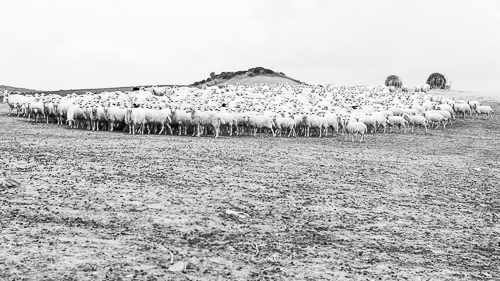The farm and guest house Su Grabiolu is located in the countryside between Siamanna and Villaurbana. A flat rock with an inscription of a fawn was placed next to the entrance to the farm of Giovanni Busìa and his wife Michela Murgia. Together they manage the guest house, an educational farm, animal husbandry and a farmhouse dairy. Upon arrival, Giovanni invited us inside the guest house and started telling us the history of Su Gabriolu. His ancestors had mainly worked as shepherds at least since 1800 originating from Barbagia and being natives of Fonni. He told us about his grandfather and his great-grandfather who arrived at Siamanna in 1880 with his family bringing almost nothing. Almost all men from Fonni practised transhumance, bringing their livestock to places with more or less fresh grass, meaning that they mainly moved their animals into the mountains in summer and into the valleys in winter. His great-grandfather was the first to buy land in the early 1900s and to build a small shelter for provisions, for storing cheese derived from sheep’s milk and protecting the sheep. His grandfather built a house for his family in the same place and his father built another and more comfortable one, both on the same property where Giovanni is continuing the activity started by his great-grandfather and where he has built the houses constituting the present Su Gabriolu and extended the property together with his wife.
Today Giovanni has a few hundred sheep, some donkeys, horses and pigs, a farmhouse dairy, a large property on which is cultivated fodder for the animals and various machines and vehicles for working the lands. Briefly, a multi-functional enterprise, a very big change during about 130 years.
I have visited various farms in Sardinia, seen how they cultivate fodder for the animals, how they are bred, how they are milked and how the milk is turned into cheese, but there is one thing which distinguishes Su Grabiolu from the other farms and that is production of sheep’s cheese without lactose. The idea of shifting from producing conventional cheese to cheese without lactose came to Giovanni when he realised that selling milk to the big dairys wouldn’t pay him what he needed to make a living nor making cheese for supermarket chains.
Both he and his wife talked with persons who didn’t eat cheese because of lactose intolerance (the inability to digest lactose, a sugar found in milk and to a lesser extent milk-derived dairy products). Having discovered that nobody else were producing cheese without lactose, they decided to start doing it. Gradually, Giovanni succeeded in lowering the contents of lactose to less than 0.01% reaching an important goal because the number of people having lactose intolerance is increasing , leading to an increased demand for high quality, digestible cheese.
Giovanni uses raw milk, meaning that it has not been pasteurised or homogenised, for making this type of cheese. Thus, the milk has only been warmed up to about 40°C in order to make cheese. The cheeses are aged for at least two months in order to make inactive any dangerous microorganisms occurring in the raw milk.
Naturally, producing cheese from raw milk sets very high requirements to hygiene, but this is compensated by the organoleptic properties derived from raw milk, giving the resulting sheep’s cheese a characteristic taste and aroma. Another distinctive trait of this cheese without lactose is that it is made with vegetable rennet, while the majority of cheese is made with animal rennet. The vegetable rennet is derived from a mold, and according to Giovanni, it makes the taste of the finished product more intense. Using a vegetable rennet makes the cheeses acceptable for eating by Muslims, but Giovanni also plans to get his cheeses approved as kosher food within 2014, making them suitable for sale in Israel.
Giovanni is a very determined person who wants to make his products conform to the requirements of the highest quality and he has made a consistent choice: cease production of high quantities and replace it with high quality. He has changed the fodder of the animals from using concentrated animal feed with added vitamins and chemicals with more organic produce, rich in cereals and grass like tall fescue, which is good for soil conservation, and clover, which fixes nitrogen, reducing the need for synthetic fertilisers. In fact, having shifted the fodder of the sheep,they produce milk having a low level of cholesterol and Giovanni will probably succeed in getting his cheeses be certified as having a low quantity of cholesterol during 2014.
For the moment Su Grabiolu sells its products mainly in Sardinia, but they are really trying to export them as described above, selling them on-line and to fair trade groups.

